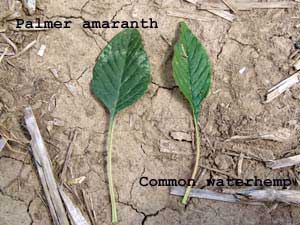LINKS
Mature Pigweed Identification
Larry Steckel, Professor
Weed Specialist
Print-Ready PDF Publication (Mature Pigweed Identification W072)
Pigweed species are most easily identified when they are nearing maturity. The flowering structures of pigweeds are relatively distinct for each individual species. The flowering structure (seedheads) of many pigweeds is a series of flowering branches with few to no leaves. They typically vary between species by their length, diameter, degree of branching and shape. At harvest time it is helpful to correctly identify the pigweeds in your fields. This information can provide changes in next years’ weed management program to better control pigweeds.
The following are some guidelines to help with pigweed identification. It should be noted, however, that there is often physical variation within species and that crossing can occur within some species of pigweed resulting in hybrid plants. Pigweeds will not always express specific traits of one parent species, but may express a combination of both.
Smooth pigweed (Amaranthus hybridus)
- Plants will have very small fine hairs throughout.
- Flowering structure is highly branched (Figure 1).
- Flowering stems are the shortest of the pigweeds (<1.5”) (Figure 1).
- Easily distinguished from redroot pigweed only in mature stages.
Redroot pigweed (Amaranthus retroflexus)
- Very fine hairs are often found throughout the plant, though stems below the cotyledons can be smooth.
- Flowering structure is branched with many thick flowering stems that range from 4 to 7” in length (Figure 1 and 2).
- Leaf and stem surfaces are rough.
Slender pigweed also
know as Green pigweed (Amaranthus gracilis) or (Amaranthus viridis)
- Flowering stems typically small and less than 3” long (Figure 2).
- Developing flowering structures are distinct from other pigweeds. They resemble an unfertilized grape vine (Figure 3).
- Leaves are egg-shaped and notched at the tip (Figure 3).
- Leaves and stems are hairless.
- Leaf surface has a rough texture and sometimes contains a v-shaped variegation (having marks or patches of varied colors or shades of one color), also called a watermark (Figure 4).
Palmer pigweed (Amaranthus palmeri)
Flowering stems are the longest (1 to 2’) of the pigweeds (Figure 2 and 5).
- The petioles (the stalk of the leaf blade) are typically longer than the leaf blades.
- Leaves of Palmer are wider than waterhemp leaves.
- Later leaves may occasionally have a white or red v-shaped variegation (watermark).
- Back of leaves are usually waxy.
Flowering stems are highly branched, narrow and typically 4 to 6” long (Figure 6).
Leaves and stems are completely hairless, very smooth, and waxy in appearance.
Leaves are long and typically narrow (Figure 7).
Plants are more slender than Palmer and have more branching.
Spiny amaranth (Amaranthus spinosus)
- Sharp spines 2 to 4 in number occur at nodes (points of leaf attachment to stems).
- Leaves often have v-shaped variegation.
- Stems are hairless and smooth.
- Flowering structure much less branched than other pigweeds.
- Flowering stems are 2 to 4” long.
Literature Cited:
Gleason, H. A. and A. Cronquist. 1963. Manual of plants. 280-282.
Horak, M. J., D. E. Peterson, D. J. Chessman, and L. M. Wax. 1994. Pigweed identification: A pictorial guide to the common pigweeds of the Great Plains. Publication S80. Manhattan, KS: Kansas Cooperative Extension Service.
Sauer, J. 1956. Recent migration and evolution of the dioecious amaranths. Evolution 11:11-31.














